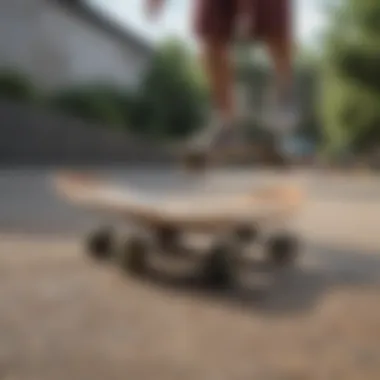Unveiling the Impact of Skateboard Deck Length on Performance


Skateboarding News Updates
Skateboarding is a dynamic sport constantly evolving with new trends and innovations. Keeping abreast with the latest skateboarding news is crucial for enthusiasts seeking to stay informed about competitions, product launches, and upcoming events. Stay tuned for updates on recent skate competitions, exciting new product releases, and coverage of thrilling skateboarding events.
Trick Tutorials and Guides
Skateboarding encompasses a wide range of tricks suitable for skaters of all levels, from beginners to seasoned professionals. Delve into detailed breakdowns of fundamental tricks for beginners, receive valuable tips for mastering advanced maneuvers, and explore the intricacies of freestyle and street skate techniques to enhance your skill set and expand your repertoire.
Skateboarding Culture and Lifestyle
Skateboarding is more than just a sport; it embodies a vibrant culture and unique lifestyle embraced by enthusiasts worldwide. Dive into spotlights featuring influential figures within the skateboarding community, explore insightful skatepark reviews, and stay updated on the latest fashion trends shaping the skateboarding scene, reflecting the lifestyle and ethos of skateboarders.
Gear Reviews and Recommendations
Selecting the right gear is essential for optimizing performance and ensuring safety while skating. Discover in-depth reviews of skateboard decks, comparisons of trucks and wheels to enhance ride quality, and receive expert recommendations on protective gear to safeguard against potential injuries, offering valuable insights to assist in making informed gear choices.
Healthy Lifestyle for Skaters
Maintaining a healthy lifestyle is integral to thriving in the demanding sport of skateboarding. Explore a curated selection of injury prevention exercises tailored for skaters, delve into fitness and strength training programs designed to boost performance, and uncover essential nutrition tips to fuel your body for peak skateboarding endeavors, prioritizing holistic well-being and longevity in skateboarding pursuits.
Introduction
Skateboard deck length is a critical factor that significantly influences performance in skateboarding. Whether you're just starting out on a board or a seasoned rider aiming to master advanced tricks, the length of your skateboard deck can make a world of difference in terms of maneuverability, stability, and overall control. Understanding the nuances related to skateboard deck length is key to improving your skills and enhancing your skateboarding experience.
Understanding Skateboard Deck Length
The Basics of Skateboard Deck Length
When it comes to the basics of skateboard deck length, we are delving into the fundamental aspect that serves as the foundation for a skater's performance. The length of a skateboard deck directly impacts a skater's balance, pop, and comfort during various maneuvers. Opting for the right deck length based on individual preferences and objectives is crucial for optimizing performance and enjoyment on the board. While longer decks offer enhanced stability and control, shorter decks provide increased agility and responsiveness, catering to different styles of skating and rider preferences.
Impact of Deck Length on Performance


The impact of deck length on performance is profound, shaping the way skaters approach different tricks and techniques. A longer deck affords riders greater stability, making it ideal for cruising, ramps, and transitions, while a shorter deck enhances maneuverability and flip tricks, suited for street skating and technical maneuvers. Understanding how deck length influences performance aids skaters in choosing the right board that aligns with their skill level, style, and riding goals, ensuring a seamless and optimized skateboarding experience.
Significance in Skateboarding
Key Role in Rider Experience
The deck length plays a pivotal role in shaping a rider's experience on the board, dictating how they interact with various skateboarding elements. Choosing the appropriate deck length based on personal preferences and riding objectives is vital for achieving a harmonious balance between stability, control, and maneuverability. Skaters must consider their individual style, preferred terrains, and skill level when selecting a deck to ensure optimal performance and comfort during their skate sessions.
Relation to Skill Level
The relationship between deck length and skill level is intricate, with different lengths catering to varying proficiency levels and skateboarding styles. Beginner riders may benefit from longer decks that offer stability and ease of control, aiding in skill development and building confidence on the board. In contrast, advanced skaters might opt for shorter decks to enhance agility and precision in executing technical tricks and maneuvers, pushing the boundaries of their skill set. Understanding how deck length correlates with skill level empowers skaters to make informed decisions that complement their abilities and aspirations in the ever-evolving world of skateboarding.
Choosing the Right Deck Length
When it comes to the intricate world of skateboarding, selecting the appropriate deck length is of paramount importance. The right deck length can significantly impact a skater's performance, balance, and overall experience on the board. By choosing the right deck length, skaters can enhance their maneuverability, stability, and control, catering to their specific skating style and skill level. Understanding the nuances of deck lengths is crucial, as it directly influences how a skater interacts with their board, executes tricks, and navigates various terrains.
Factors to Consider
Height and Shoe Size
Height and shoe size are pivotal factors to consider when determining the ideal deck length. Skaters with taller stature and larger shoe sizes may benefit from longer decks, offering greater stability and foot placement. Conversely, skaters with a shorter height and smaller shoe size may find more success with shorter decks, facilitating quicker turns and better board control. The relationship between height, shoe size, and deck length is intricate, as it directly impacts a skater's comfort, balance, and ability to perform tricks effectively. Understanding how height and shoe size correlate with deck length can guide skaters towards selecting a deck that optimizes their performance and riding experience.
Skating Style
A skater's individual skating style is another crucial element to consider when choosing the right deck length. Different skating styles, such as street skating, vert skating, or cruising, may require varying deck lengths to accommodate specific maneuvers and tricks. For example, street skaters who focus on technical tricks and flips may prefer shorter decks for increased responsiveness and agility. In contrast, vert skaters who perform high-speed aerial maneuvers may opt for longer decks to maintain stability and control during transitions. By aligning deck length with skating style, skaters can maximize their performance potential and achieve their desired outcomes on the board.
Experimental Approaches
Trial and Error Method
Engaging in a trial and error method can be a beneficial approach to finding the optimal deck length for individual preferences and riding style. By testing different deck lengths and evaluating how each impacts stability, maneuverability, and comfort, skaters can gain valuable insights into their specific needs and preferences. This experimental approach allows skaters to fine-tune their deck length selection based on firsthand experiences and direct feedback from their performance on the board, promoting a customized and tailored riding experience.
Professional Recommendations


Seeking professional recommendations from experienced skaters, skate shop specialists, or trainers can provide valuable guidance in choosing the right deck length. Professionals in the skateboarding industry possess in-depth knowledge of deck characteristics, performance attributes, and best practices for matching deck length to individual requirements. By leveraging professional expertise, skaters can receive personalized recommendations tailored to their skill level, goals, and riding preferences, ensuring an informed and strategic decision-making process in selecting the optimal deck length for enhanced performance and enjoyment on the board.
Impact on Performance
Skateboard deck length is a critical factor that significantly affects a skater's performance on the board. The length of the deck plays a crucial role in determining how stable or maneuverable a skateboard feels while riding. Understanding the impact of deck length on performance is essential for skaters looking to enhance their skills and capabilities on the board. This section will explore the key components that make up the performance aspect influenced by skateboard deck length.
Stability vs. Maneuverability
Dynamics of Stability
In the realm of skateboarding, stability stands out as a fundamental element essential for beginners to master before advancing their skills. Stability is the backbone of control and confidence on a skateboard. A longer deck length generally contributes to increased stability due to a wider wheelbase, allowing for better balance and control when cruising or performing basic tricks. However, an overly long deck may sacrifice maneuverability, making it challenging to execute sharp turns or intricate maneuvers that demand agility. Striking a balance between stability and maneuverability is key for skaters of all levels to achieve optimal performance.
Enhanced Maneuverability
On the flip side, maneuverability is paramount for skaters looking to push the boundaries of their skills and perform complex tricks with finesse. Shorter skateboard decks are favored for their enhanced maneuverability, enabling riders to navigate tight spaces and execute quick turns with precision. A shorter deck length results in a smaller turning radius, facilitating swift movements and fluid transitions between tricks. While sacrificing some stability, enhanced maneuverability offers skaters the freedom to explore a wider range of technical tricks and evolving their skateboarding style.
Tricks and Techniques
Affect on Ollies and Kickflips
The length of a skateboard deck significantly impacts the performance of fundamental tricks like Ollies and Kickflips. A shorter deck provides increased leverage and pop for executing high Ollies, while a longer deck offers more stability during the landing phase. Skaters must consider their preferred trick repertoire and style when selecting the appropriate deck length to optimize their trick execution.
Precision in Grinds
When it comes to specialized tricks like grinds, precision is key to mastering the art of skateboarding. The deck's length influences the skater's ability to lock into grinds with accuracy and consistency. A longer deck provides a larger surface area for stabilizing grinds, while a shorter deck offers greater control and responsiveness for executing technical grinds. Choosing the right deck length plays a pivotal role in enhancing a skater's precision during grind-based maneuvers, influencing the overall fluidity and style of their skateboarding performance.
Comparative Analysis
In this segment of the article, we will delve into the crucial significance of conducting a comparative analysis of different skateboard deck lengths. The relevance of this comparative analysis lies in its ability to provide skateboarders with a comprehensive understanding of how varying deck lengths impact their performance. By contrasting standard, long, and mini decks, riders can make informed decisions based on their skill level, skating style, and desired outcomes. This comparative approach allows skaters to assess the trade-offs between stability and maneuverability, enabling them to tailor their equipment to suit their unique preferences and objectives.
Length Variations in Skateboard Decks


Comparing Standard, Long, and Mini Decks
Analyzing the differences among standard, long, and mini skateboard decks is crucial in understanding the diverse options available to skaters. Each deck length offers distinct characteristics that cater to specific riding preferences and styles. Standard decks provide a balanced approach, offering stability and maneuverability suitable for a wide range of skaters. Long decks emphasize stability, making them ideal for cruising and downhill riding, while sacrificing some maneuverability. On the other hand, mini decks prioritize agility and quick turns, making them popular choices among street skaters and technical riders. The choice between standard, long, and mini decks ultimately depends on the rider's skill level, riding style, and intended tricks. While standard decks are versatile and widely used, long decks excel in stability, and mini decks are favored for tricks requiring precise control. Understanding the nuances of each deck length empowers skaters to optimize their performance and enhance their overall skateboarding experience.
Technological Advancements
In the realm of skateboarding, technological advancements play a crucial role in pushing the boundaries of performance and design. For skateboarders seeking to maximize their skills and optimize their equipment, staying updated on the latest technological innovations is paramount. Technological advancements pave the way for enhanced skateboarding experiences, driving progress within the sport.
Innovations in Deck Design
Development of Concave Shapes
The development of concave shapes in skateboard decks represents a significant evolution in deck design. Concave shapes refer to the curvature or inward curve along the width of the deck, creating a concave profile. This feature contributes to improved foot grip and control, allowing riders to execute tricks with more precision and stability. The concave shape enhances the rider's connection to the board, facilitating smoother transitions between maneuvers and boosting overall performance. Its popularity stems from the tangible benefits it offers in terms of maneuverability and responsiveness. Although individual preferences may vary, the concave shape is widely recognized for its positive impact on skateboarding dynamics.
Materials and Weight Distribution
Another pivotal aspect of deck design is the materials used and how weight is distributed throughout the deck. The choice of materials, such as maple wood or composite materials, impacts the deck's durability, flexibility, and overall feel. Additionally, strategically distributing weight along the deck influences its responsiveness and stability during tricks and maneuvers. Finding the right balance between materials and weight distribution is essential for creating a deck that meets the performance needs of riders. While different materials and distribution techniques offer unique advantages, such as lightweight construction or targeted reinforcement, they also come with trade-offs that riders must consider. Understanding the implications of materials and weight distribution is crucial in selecting a deck that aligns with individual skating styles and preferences.
Customization Trends
In the realm of skateboard design, customization trends allow riders to personalize their equipment for enhanced performance and aesthetics. Tailoring deck lengths to individual preferences has gained traction among skateboard enthusiasts, as it enables a more customized riding experience. By adjusting deck lengths, riders can fine-tune their setups to optimize control and comfort, fostering a deeper connection between rider and board.
Personalized Deck Lengths
Personalized deck lengths cater to the unique needs and preferences of riders, offering a tailored solution for optimizing performance. Riders can choose deck lengths that suit their body dimensions, skating style, and maneuvering preferences, ensuring a more personalized and comfortable riding experience. This customization empowers riders to leverage their strengths and overcome potential limitations, enhancing their overall performance and enjoyment on the board.
Artistic and Functional Designs
Artistic and functional designs in skateboard customization combine aesthetics with performance-enhancing features. Deck designs that integrate artistic elements while maintaining functionality appeal to riders seeking a blend of style and substance. By incorporating unique graphics, textures, and shapes, skateboarders can express their individuality and creativity through their equipment. These designs not only add visual interest but also contribute to the overall feel and performance of the deck, enhancing the rider's experience on and off the ramps.
This detailed exploration of technological advancements in skateboard deck design highlights the industry's continuous innovation and dedication to enhancing the skateboarding experience for riders of all levels.
Future Prospects
Skateboarding is a sport that continually evolves, pushing boundaries and exploring new horizons. The Future Prospects section of this article delves into the exciting realm of what lies ahead for skateboard deck lengths. Understanding the direction in which skateboarding is heading is crucial for enthusiasts looking to stay ahead of the curve. By forecasting emerging trends in deck lengths, skaters can anticipate the next wave of innovations that will shape the future of the sport. This section not only sheds light on the evolution of skateboard deck design but also paves the way for informed decision-making when selecting the optimal deck length for individual preferences and performance needs.
Evolution in Skateboarding
In the ever-changing landscape of skateboarding, the Evolution in Skateboarding section acts as a compass, guiding readers through the transformative journey of the sport. Forecasting Trends in Deck Lengths is a pivotal aspect of this evolution, as it provides valuable insights into the direction skateboard design is headed. By analyzing past trends and projecting future developments, skaters gain a profound understanding of how deck lengths will impact performance in the years to come. The Forecasting Trends in Deck Lengths not only serves as a tool for staying updated with industry shifts but also enables riders to adapt their skills and equipment to meet the demands of an ever-evolving skateboarding landscape. With a keen focus on innovation and progression, this section explores the nuances of Forecasting Trends in Deck Lengths, highlighting its significance in shaping the future of skateboarding.







